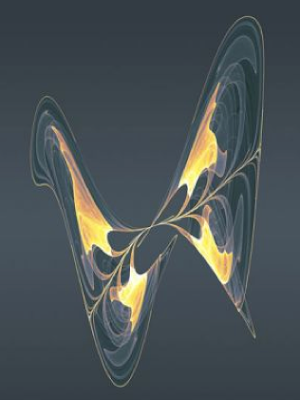Sunday, December 25, 2011
Friday, December 23, 2011
Monday, December 19, 2011
Thursday, December 15, 2011
Wednesday, December 14, 2011
This image was created by Jonathan McCabe from a cellular automata program he wrote.
"Each pixel represents the state of the 4 cells of 4 cellular automata, which are cross coupled and have their individual state transition tables. There is a "history" or "memory" of the previous states which is used as an offset into the state transition tables, resulting in update rules which depend on what has happened at that pixel in previous generations. Different regions end up in a particular state or cycle of states, and act very much like immiscible liquids with surface tension."
Tuesday, December 13, 2011
John Conway's Game of Life is a cellular automaton in which randomized cells evolve according to a fixed set of rules. Usually this evolution appears as an animation, here we see the evolution through time in a still image, with height from top to bottom corresponding to subsequent generations of cells.
Monday, December 12, 2011
"Girih tiles have interior angles that are multiples of π/5. In the examples shown here I’ve applied the girih concept to polygons with angles that are multiples of π/7."
By Joe Bartholomew
By Joe Bartholomew
The Catalan numbers are a sequence of numbers, much like the Fibonacci numbers, which are given by the equation 
Like the Fibonacci numbers, they too pop up all over the place, for example, the Catalan numbers correspond to the number of ways a regular n-gon can be divided into n-2 triangles.
Above is a visualization of the Catalan numbers.

Like the Fibonacci numbers, they too pop up all over the place, for example, the Catalan numbers correspond to the number of ways a regular n-gon can be divided into n-2 triangles.
Above is a visualization of the Catalan numbers.
Thursday, December 1, 2011
Tuesday, November 29, 2011
Thursday, November 17, 2011
100th post!
A Wolfram Demonstration titled Combinations of Sines in the Complex Plane by Stephen Wolfram. He writes "Combinations of two sine functions must always have their zeros on the real line. Combinations of three need not. The height here is the absolute value of the sum of sine functions; the hue is the phase."
Wednesday, November 16, 2011
These images are from a Wolfram Demonstration by Michael Schreiber titled Complex Exponential Resonance. He writes "Complex exponentials of complex exponentials feature resonance patterns. There is only one polygon; black regions are under an odd number of self-overlays."
Tuesday, November 8, 2011
This sculpture is 8 feet in diameter and, from what I can tell, is a compound of five octahedra (a stellation of the icosahedron). The designs are projected onto its surface.
“Parmenides I” by artist Dev Harlan
Tuesday, November 1, 2011
Monday, October 17, 2011
Monday, October 10, 2011
Monday, September 26, 2011
Tuesday, August 30, 2011
I just finished watching "Between the Folds," a documentary on origami and paper folding by Vanessa Gould, and was blown away by some of the amazing works and artists in the film. One of my favorites was Chris Palmer, whose works are about movement and light.
This video is inspired by some of his other pieces:
This video is inspired by some of his other pieces:
Thursday, August 25, 2011
An image from an awesome demo by Ed Pegg Jr. that's part of the Wolfram Demonstrations Project. This image corresponds to Gaussian integers raised to the 11th power. The demo allows one to view Gaussian integers raised to any fractional power. The user can choose a numerator and denominator less than 20.
Gaussian integers raised to the 17/6 th power
Gaussian integers raised to the 17/6 th power
Sunday, August 14, 2011
Saturday, August 13, 2011
This image by Gabriel Doyle is a representation of the universal cover of the doubly-pointed Heegaard diagram of genus 1 of a (1,1)-knot.
"Octopod" by Syntopia (Mikael Hvidtfeldt Christensen) is an example of algorithmic art.
"In algorithmic art the creative design is the result of an algorithmic process, usually using a random or pseudo-random process to produce variability."
"In algorithmic art the creative design is the result of an algorithmic process, usually using a random or pseudo-random process to produce variability."
Saturday, August 6, 2011
"Equal Areas" by Susan McBurney.
This image, inspired by Leonardo DaVinci, builds upon a concept of equal areas. The sum of the areas of the red shapes in the bordering semicircles is equal to the sum of the areas of the red shapes inside the center circle; and the same goes for the green, yellow, pink, and peach shapes.
This image, inspired by Leonardo DaVinci, builds upon a concept of equal areas. The sum of the areas of the red shapes in the bordering semicircles is equal to the sum of the areas of the red shapes inside the center circle; and the same goes for the green, yellow, pink, and peach shapes.
"Knot Structured" by George W. Hart was made by assembling 30 identical pieces of laser-cut wood. Read more here.
Friday, July 29, 2011
Stability and chaos are analyzed by computing the Lyaponuv exponent which is plotted above.
Friday, July 15, 2011
A generalization of the Cornu spiral, this is an example of a polynomial spiral described by Dillen (1990) for which the curvature is a polynomial function of the arc length.
Subscribe to:
Posts (Atom)
















































